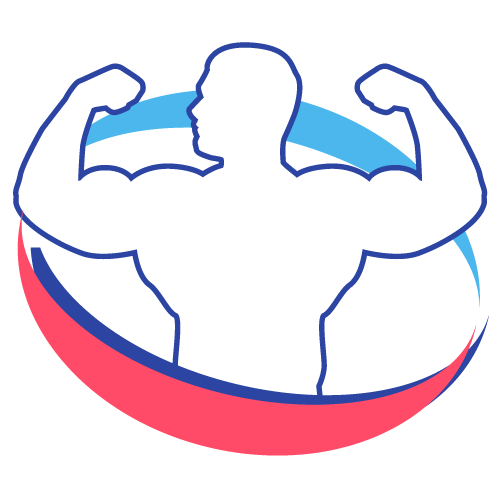
Welcome to the Gauntlet
The most effective way to build total-body muscle in 1 hour
Want to develop total body muscle in just 1 hour a week?
Want a workout that gives you progress each week to keep you motivated?
Want to burn fat to reveal an athletic physique?
If yes, read on to see how it can be done.
The Gauntlet Workout
Key Notes
- 1 hour of physical punishment per week, giving maximum effort throughout
- Maintain good form to prevent injury
- If you can complete the gauntlet in less than 45 minutes, go heavier
- If it takes more than 1 hour to complete, go lighter
- Each session, record your time and how you felt on the day to measure your progress
- After your workout, eat well & see results
Exercise Breakdown – How to complete the Gauntlet
The Creation
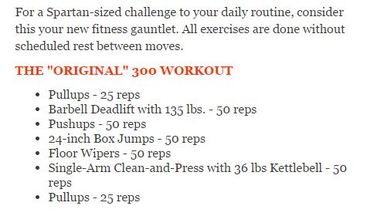
As you may or may not know, this routine was born from a particularly heavy period of my life in which I wanted to look and feel better but only had a single gym session to make it happen.
I took inspiration from the “Spartan workout”, which is apparently the workout used to get the stars of 300 into such impressive shape. I’m sure you would agree it’s a nice physique to strive for…..
Sadly I quickly realized I could barely do 2 consecutive pull ups, never mind the 25 at the beginning and end of the workout as suggested!
This lead me to scale down the workout to make it a bit more manageable, something I called the “Junior Spartan”.
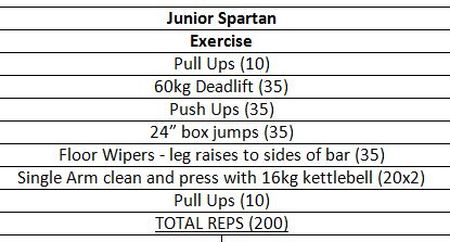
This was aimed to be a “stepping stone” style workout, developing the strength and muscular endurance to cope with the original 300 workout.
Very quickly I realized that although this would be a “good” workout to do once a week, I knew it wouldn’t develop the extra muscles I wanted to have a balanced and aesthetic physique, such as calf muscles or my traps (the muscles between the shoulders and the neck that can make you apparently look like a smaller version of yourself trying to escape your own body….. (1) ).
Due to this I began work on creating a new workout, one that hit as many muscles as possible so over time I’d have the balanced and aesthetic physique I was aiming for.
The Name
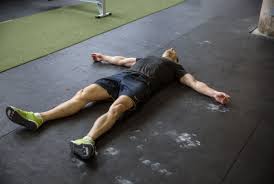
So began the creation of the gauntlet. It’s affectionately called the gauntlet after the term “running the gauntlet”, a form of physical punishment used in Roman times (well at least wiki told it was Roman, so I’m going with Roman…), each set should be difficult enough that it can’t be completed in a single set and might be likened to the physical blows endured by the people standing in the gauntlet (though if anyone actually dies, I’m super sorry / accept no liability).
Additionally, compound movements are used to maximize the amount of muscles that are recruited during the workout and once it’s completed, you should feel pretty exhausted, drained and ready for lots of food and rest to recover your body (I’ve always found an “all in one” protein shake with honey mixed in, followed by a Nandos with friends to be just the ticket).
Quick note: If you can communicate with any other people in the gym more articulately than grunting… You’re not working hard enough.
The Science
All workouts are to be completed to time, but with a focus on form (there’s not much use doing half reps on the bench press once a week!). With regards to how long it should take? Anywhere between 45-60 minutes, if it takes longer than 60 minutes, reduce the weight, if it’s quicker than 45 minutes then increase the weight, you want to maximize the volume worked by your muscles without going too far past the 1 hour mark, if you do, you’ll be reducing the effects of testosterone (which you don’t want) and increasing the amount of cortisol (which you also don’t want) – both these changes in hormones will have a negative effect on your gains and muscle growth (2), (3), (4).
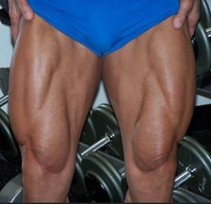
Why workout to time? Personally, having dabbled with weights prior to teaching without making much progress, I stuck to the typical 10 x 3 rep and set structure, but found that there was never any quantifiable time at which to increase the weight, if I can do the same reps with an extra 2kg but struggle much more, can I guarantee I’ve grown in strength and/or size?
For me I like having numbers and the idea behind timed workouts is that, if you can do exactly the same reps and sets with the same weight as the week before, and you can do it faster, you’re healthier (through strength and / or cardiovascular endurance).
Additionally, both high repetitions and low repetitions work in terms of growing muscle, but the key differential is how much volume your muscles are coping with (5), (6). I.e. if Person A can squat 140kg for 8 repetitions (=1,120kg), Person B can squat 60kg for 12 repetitions (=720kg) and Person C can squat 150kg for 5 repetitions (=750kg), you can pretty much guarantee that Person A is going to have the biggest and most impressive quadriceps muscles (the muscles at the front of your thigh).
Similarly, with regards to the Gauntlet itself, if Person A can complete a specific gauntlet in 55 minutes and Person B can complete the same gauntlet with higher weights in 55 minutes, Person B will be stronger, have more muscle and a better cardiovascular system than Person A.
(My personal goal is to increase the weights on each of my exercises by an average of 5kg by the end of the calendar year whilst keeping workouts under 60 mintues – leaving me with an more muscular physique and better cardiovascular system than I have now)
Free Downloads
Whatever your current fitness level, whether you’re new in the gym or a seasoned gym veteran, download the Gauntlet which is appropriate to your current level of fitness here for free! (one that you can complete in between 45-60 minutes).
After 8 weeks, or when the workout can be completed in less than 45 minutes, make sure you increase the weight to see great results over time with at least 1 hour of intense exercise per week.
The 1 Hour Gauntlet : “How to” Guide
Not quite sure between your military presses and upright rows? Not to worry! Here you’ll find not only a description of each exercises required in the Gauntlet with variations, muscles used and how to perform the move properly, but also an image and video so that you can walk into the gym with confidence on how to perform these excellent compound movements and build an excellent physique.
Pull Ups
Description:
A full body compound move where you pull your entire body weight up so that your chest nearly reaches the bar.
Main Muscles Worked:
Lats (middle back muscles below your armpits) & biceps.
Variations:
This is a tricky exercise for those who are new to the gym, try using the lat pulldown machine to build up some strength, use an assisted pull up machine or try negative reps (holding at the top of the movement and slowly lowering yourself down)
Form:
For a full pull up, hang off a bar with your palms facing away from you, pull your body weight up without swinging, drawing your shoulder blades down your back, pull till your chest is near to the bar before lowering slowly.
Deadlift
Description:
A great full body compound move where you lift a bar from the floor up to your hips and down again. Fantastic for building total body strength and size.
Main Muscles Worked:
Lower back, hamstrings (back of thighs) & core.
Variations:
If the weight is too heavy, try lowering the weight. You may also wish to try a mixed grip (one palm forward and one palm facing backwards) to help grip the bar.
Form:
For a safe deadlift, start with feet hip-width apart and grabbing the bar close to your shins, lift the bar with straight arms, your hips starting slightly higher than your knees, chest up and be very careful not to round your back as you lift.
Dumbbell Bench Press
Description:
One of the “big three” exercises, which builds great upper body strength and mass.
Main Muscles Worked:
Pectoral muscles (chest), triceps and shoulders.
Variations:
Best performed with a slight incline on the bench for a fuller chest. If prefered, complete this movement with palms facing each other when pressing.
Form:
Sit down on incline bench with dumbbells resting on lower thigh. Kick weights to shoulders and lean back. Position dumbbells to sides of chest with upper arm under each dumbbell. Press dumbbells up with elbows to sides until arms are extended. Lower and repeat.
Incline Dumbbell Rows
Description:
The opposite movement to the incline dumbbell press, where you pull dumbbells from hanging up towards your chest.
Main Muscles Worked:
Lats (middle back muscles below your armpits), biceps & rear shoulders.
Variations:
Best completed with an overhand grip for greater rear shoulder activation.
Form:
Starting with the dumbbells hanging from your arms, pull the weights up towards your chest, lifting your elbows high before slowly lowering, rinse & repeat.
Barbell Squats
Description:
The king of lower body movements and is fantastic for developing leg strength & power.
Main Muscles Worked:
Quadriceps (front thighs), hamstrings (back thighs) and glutes (your ass).
Variations:
Legs can be placed under the shoulders or wider if preferred for greater glute development.
Form:
For a safe squat, begin with the bar on your trap muscles (the meaty section inbetween your shoulders), slowly lower your hips down till they are at least at a 90 degree angle to your knees before standing up again in a controlled fashion.
Wide Upright Row
Description:
A upper body compound pulling move which will help build your shoulders.
Main Muscles Worked:
Biceps, front & side deltoids (shoulder muscles) and traps (the meaty section inbetween your shoulders)
Variations:
Sometimes performed with a narrow grip but best performed with a wide grip for greater side shoulder activation.
Form:
Grab the bar with a grip just wider than shoulder width, raise the bar up till at least the level of your neck before lowering back down to the starting position.
Military Press
Description:
A compound pushing move which will help build your upper body and raw strength.
Main Muscles Worked:
Shoulders, triceps and upper chest.
Variations:
This can be done whilst seated, which will remove any effort from the legs to stabilize your body whilst pressing.
Form:
Begin with the bar towards your collar bones, brace your core and with control, press the bar directly up above your head. Lower slowly and repeat.
Chin Ups
Description:
Very similar to the pull up, but with a narrower grip and more focus on the biceps.
Main Muscles Worked:
Biceps & Lats (middle back muscles below your armpits)
Variations:
Not quite strong enough yet for a full chin up? Try building strength first through mimicking the movement on a pull down machine, negative repetitions or try using an assisted chin up machine if available.This move can also be done with a grip where your palms are facing each other.
Form:
For a full chin up, hang off a bar with your palms towards you, pull your body weight up without swinging, drawing your shoulder blades down your back, pull your body up till your chin is above the bar before lowering slowly.
Floor Wipers
Description:
Brought to popularity by the famed “300 workout”, this move is an excellent option for developing great abs and obliques.
Main Muscles Worked:
Lower abs, upper abs and obliques (muscles on the side of your abs)
Variations:
If holding a barbell above your head is too much, you can do this on a standard bench, whilst holding onto the barbell in the rack.
Form:
Hold a barbell above your head with arms stretched upwards, begin with your legs together on the floor. Move your legs towards one side of the barbell before lowering legs back to the floor, repeat on the other side, keep legs as straight as possible throughout the movement whilst contracting your core muscles.
Dumbbell Shrugs
Description:
Usually performed with a heavy weight, the shrug is a simple move to build powerful traps.
Main Muscles Worked:
Traps (the meaty section inbetween your shoulders)
Variations:
This can be done with either a barbell or dumbbells.
Form:
Hold the barbell or dumbbells down by your waist, shrug the weight up, ensuring you contract your trap muscles as you do so, lower the weight and then rinse & repeat.
Tricep Dips
Description:
An amazing upper body move to power up your triceps and chest.
Main Muscles Worked:
(Unsurprisingly) Triceps & chest
Variations:
This can be performed either focusing on the lower chest (by learning forward) or the triceps (body upright and arms tighter to the body). Not quite got the upper both strength yet? Try, doing dips on a bench or chair with your heels out on the floor in front of you, alternatively, use an assisted dip machine if available.
Form:
Start at the top of the exercise by gripping two bars at either side of the body, lower your body down till your arms are at a 90 degree angle, push your body weight back up to the starting position, that’s 1 rep.
Decline Sit Ups
Description:
A move to truly build a great set of abs without using conventional crunches.
Main Muscles Worked:
Lower abs, upper abs and obliques (muscles on the side of your abs)
Variations:
Best performed with a weight to develop strength (and therefore size & greater definition) in the abs. You can even perform this move using a preacher curl bench (the one predominantly used for biceps) by hooking your feet under the seat pad. If this is too difficult, try doing standard sit ups to increase core strength.
Form:
Hook your feet / ankles under the padding of the decline bench (or the seating area if your completing this move on a preacher bench), slowly lower your torso backwards and down till your back touches the bench, keep your head facing the ceiling and raise your torso up to the starting position.
Normal, Wide & Narrow Calf Press
Description:
A combination move utilizing 3 variations of the typical calf press for superior calf development.
Main Muscles Worked:
Calves
Variations:
If your gym doesn’t have a calf machine, you can do this exercise using a leg press machine or if needed, standing (though this will not give you the best range of motion)
Form:
Keeping your knees slightly bent, allow your heels to go slightly past the area you’re pressing against then push up to contract your calf muscles. First use a stance where your feel are parallel, then repeat the movement with narrow feet, finally repeat the movement with a slightly wider stance and toes pointing slightly outward.
Conclusion
So there’s a summary of all the exercises used within the gauntlet to help you achieve a better body that looks good and performs even better! As ever, if you have any questions or comments, feel free to reach out on our Facebook page.
References
(1) http://www.buzzfeed.com/awesomer/muscle-men-that-look-like-they-have-tiny-men-trying-to-es#.ba0YYwpd7X
(2) http://bodybuilding.about.com/od/weighttrainingprinciples/a/BodybuildingTrainingSecrets.htm
(3) http://www.daveywaveyfitness.com/nutrition/cortisol-and-lifting-limit-your-workouts-to-60-minutes
(4) http://www.bodybuilding.com/fun/drobson.htm
(5) http://breakingmuscle.com/strength-conditioning/you-don-t-need-to-lift-heavy-to-grow-muscle
(6) BioLayne Video Log 28 Using Training Volume and Failure Appropriately https://www.youtube.com/watch?v=qD3KxvQ9_KY
